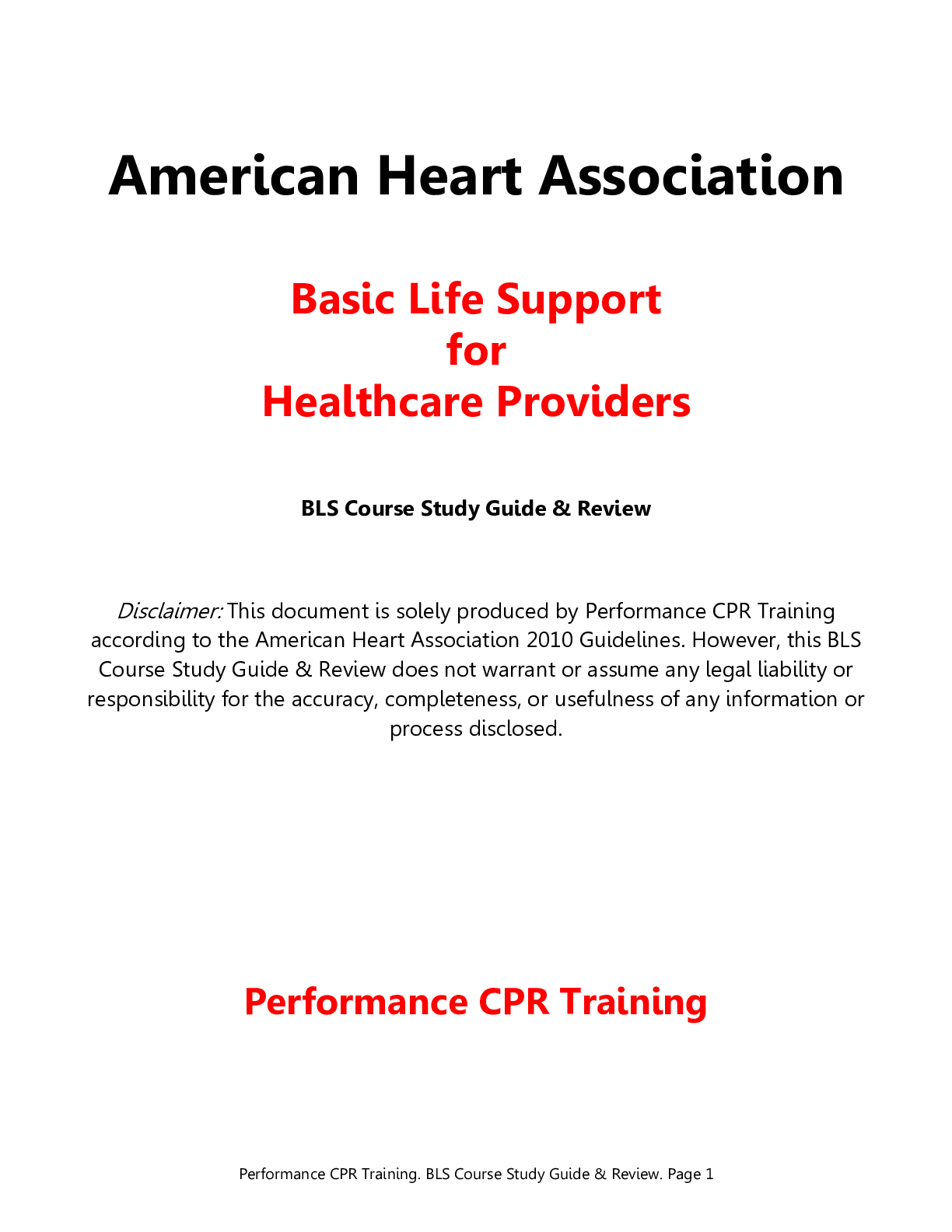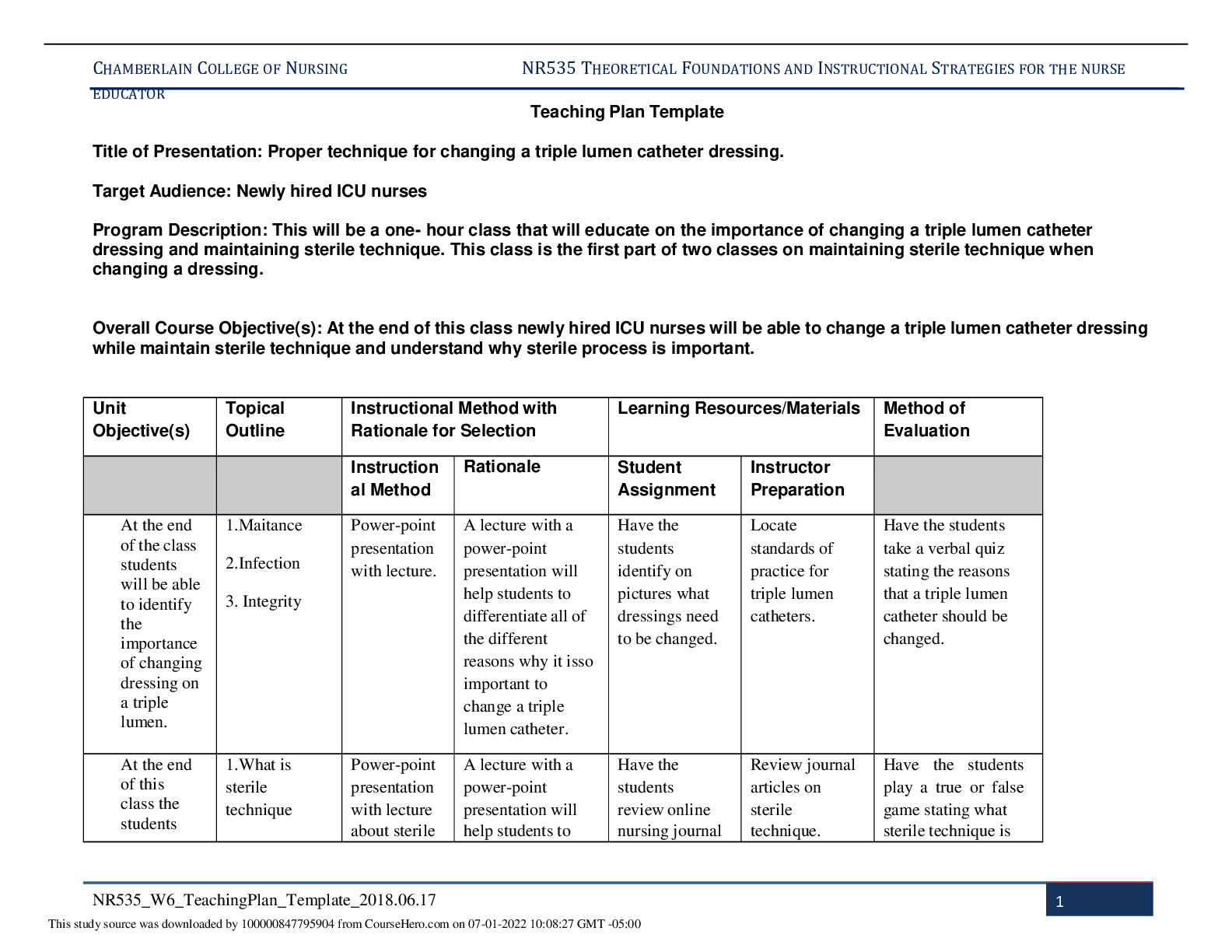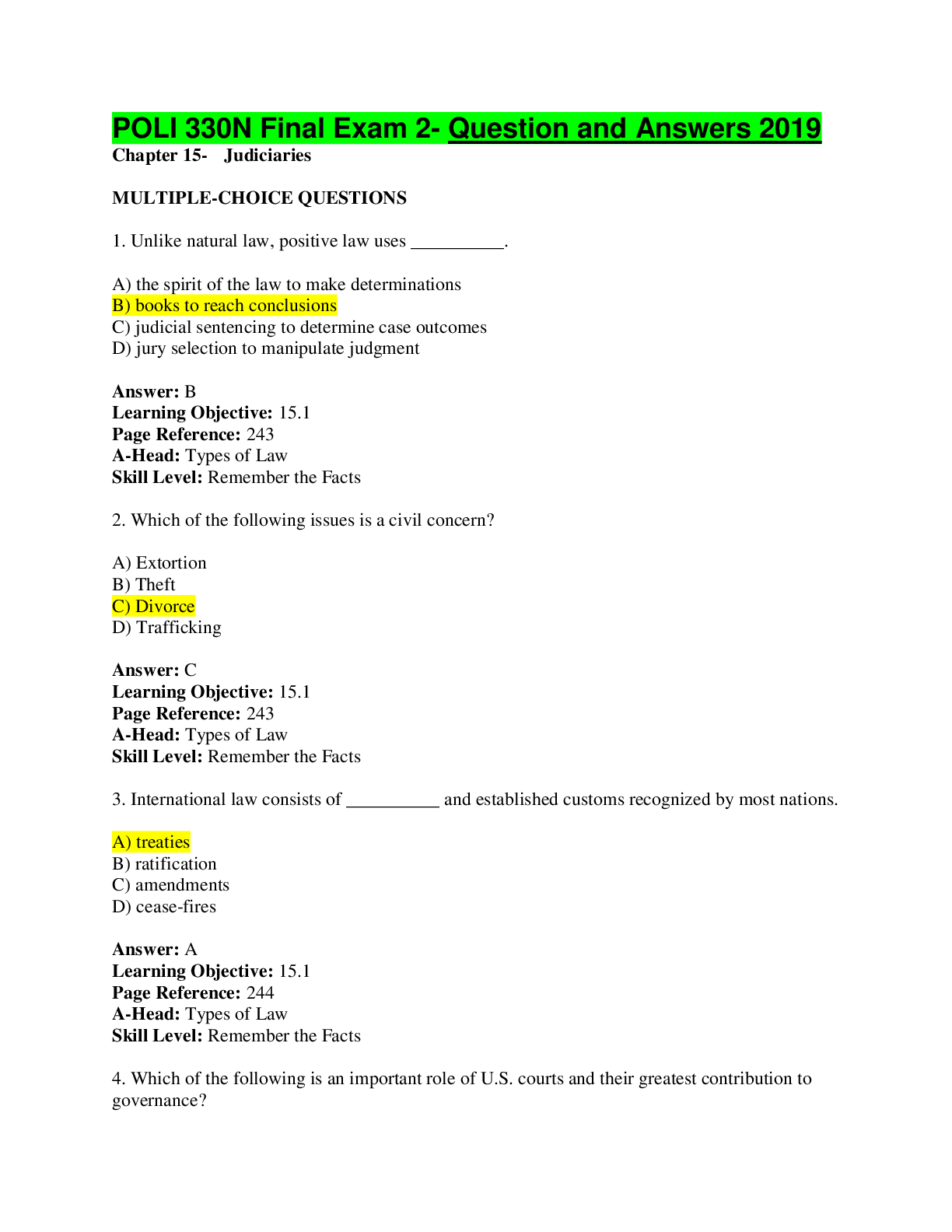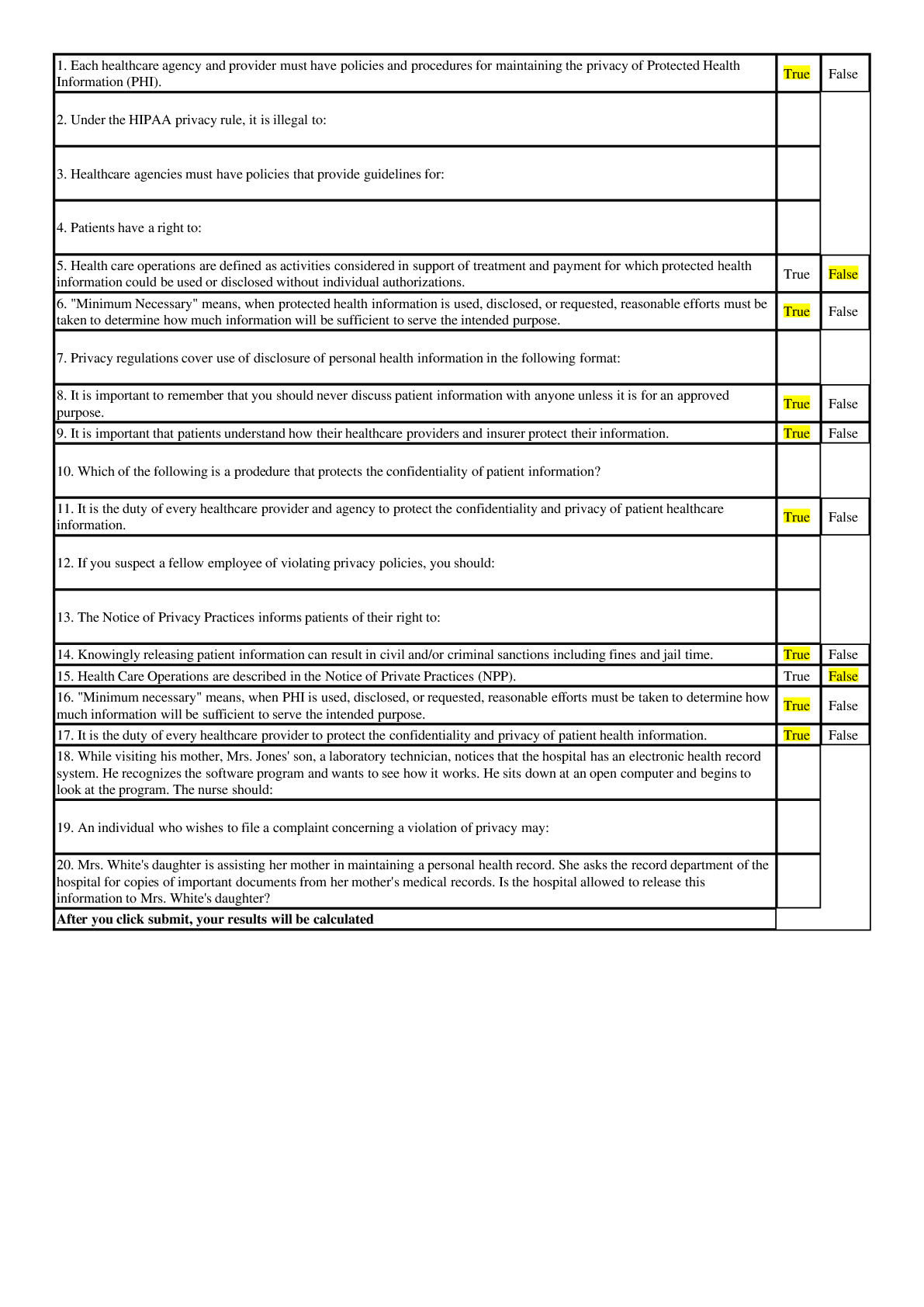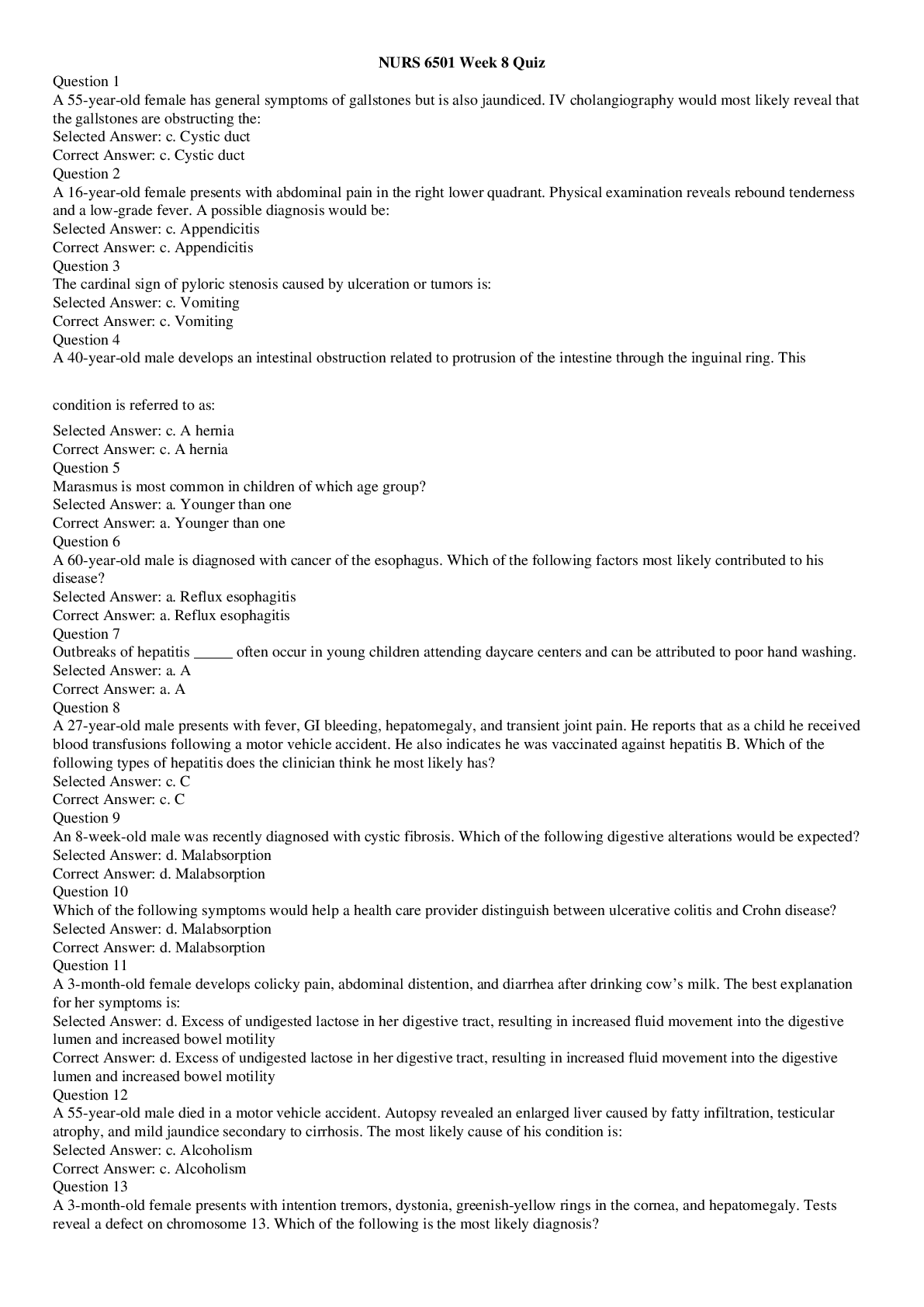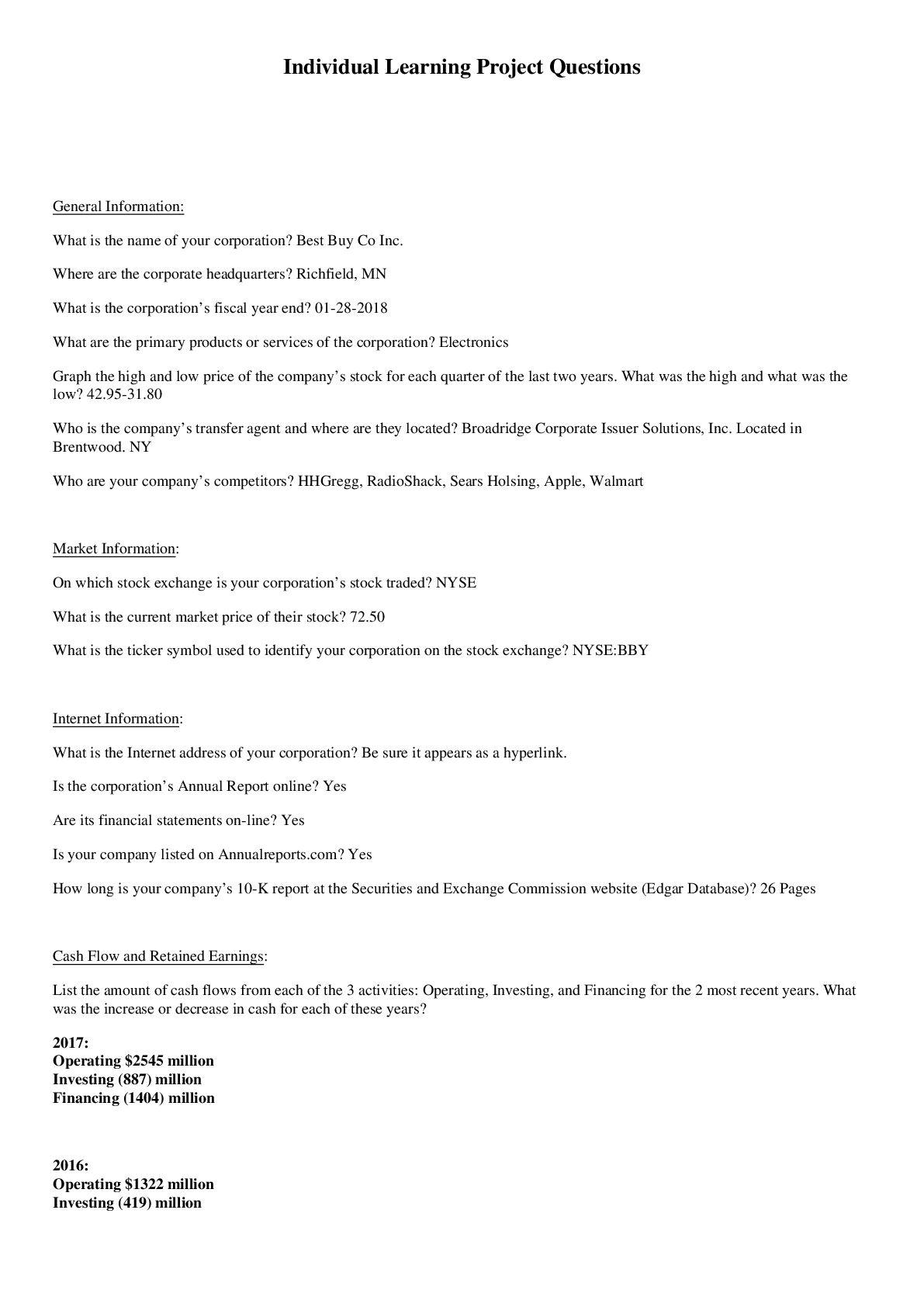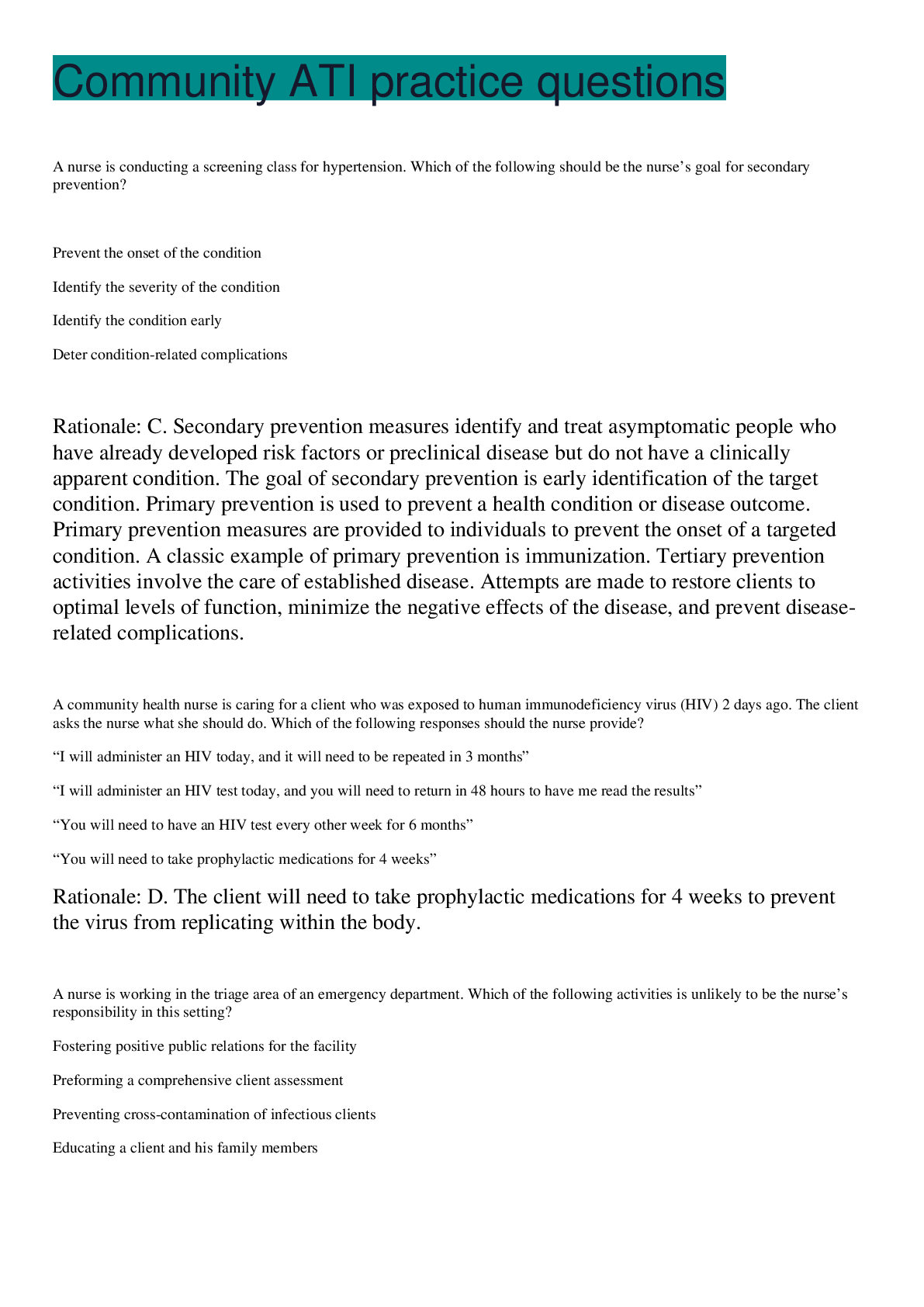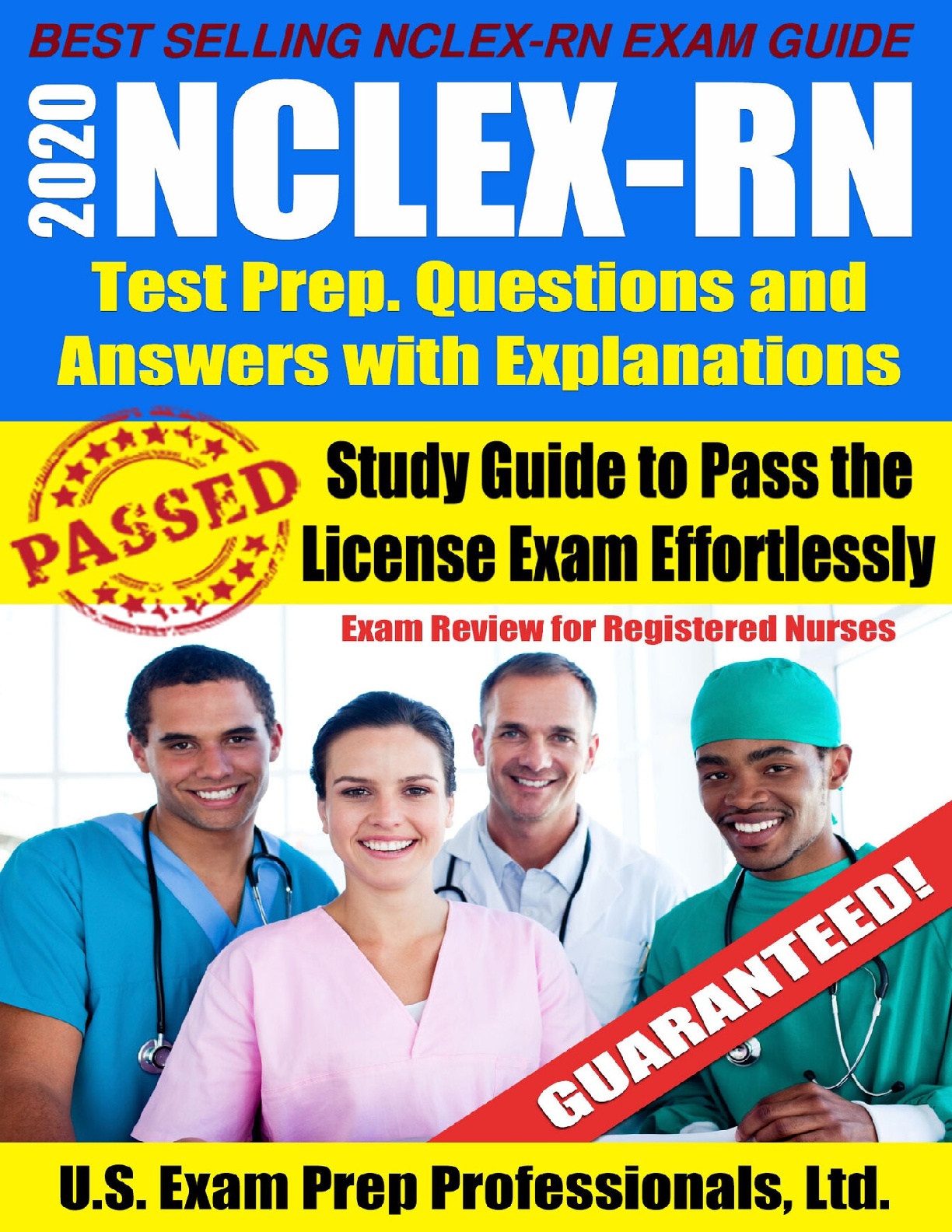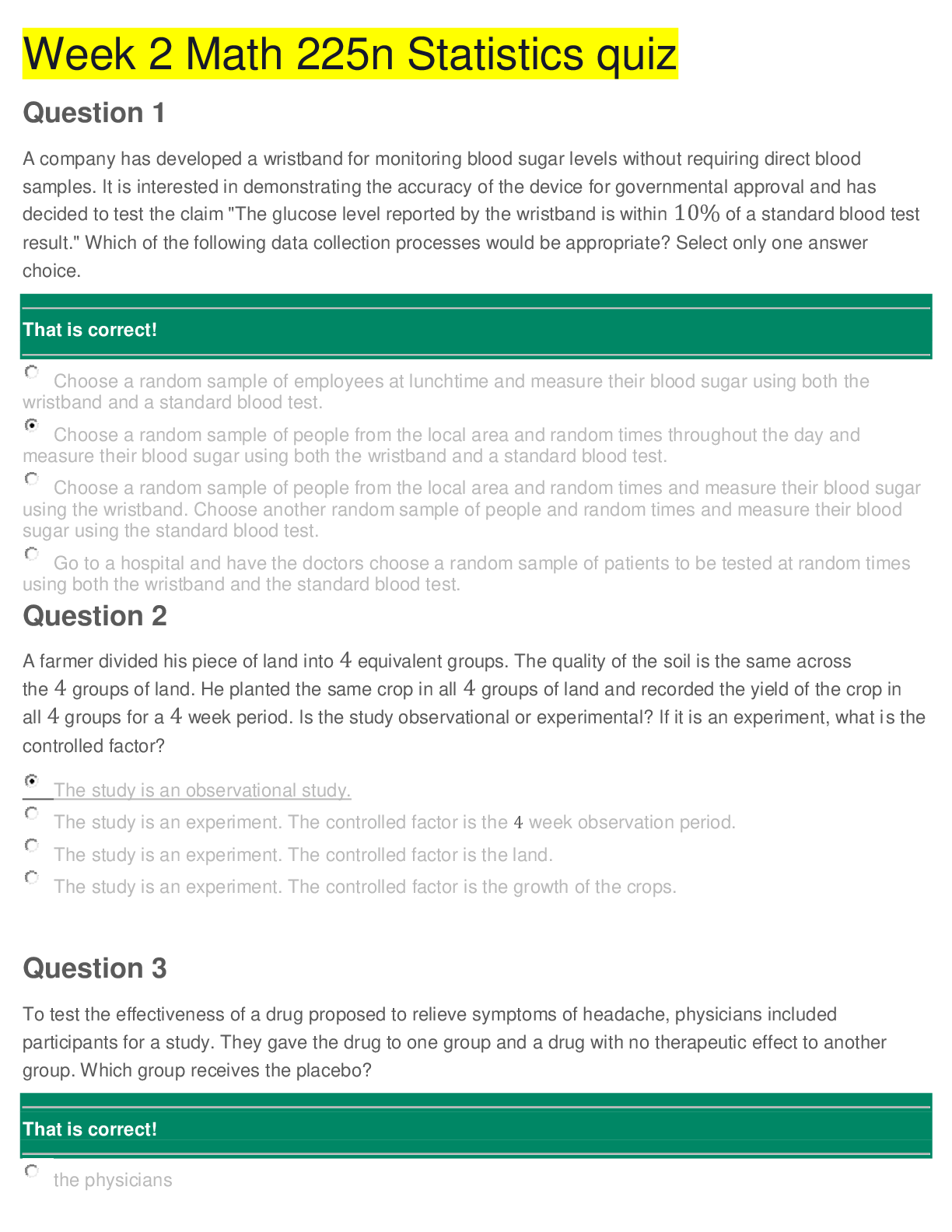*NURSING > STUDY GUIDE > MCH NUR 2633 – Study Guide Test 1/50 (GRADED A) questions and Answers | 100% VERIFIED. (All)
MCH NUR 2633 – Study Guide Test 1/50 (GRADED A) questions and Answers | 100% VERIFIED.
Document Content and Description Below
MCH NUR 2633 – Study Guide Test 1/50 questions 1. Women’s health encompasses breast care, GYN exams, and assessments. Be comfortable with the parameters of education for Self breast exams, and ... what is normal for a woman to note when doing breast exam. Know normal menstrual cycle - what is the most common complaint with the menstrual cycle, and complications; (dysmenorrhea) Know STI’s and risks. a. The most common compliant women have with menstrual cycle is abnormal bleeding, painful menses (dysmenorrhea), treatment is heating pad and NSAIDs. Other OBGYN complaints are fibroids, ovarian cysts, and endometriosis. Self-breasts exams monthly 7- 10 days after the cycle. Two hormones with women's health are Estrogen(growth hormone makes everything bigger), Progesterone(slows things down, makes lining thicker, the pregnancy will not survive without enough of this hormone) 2. If a patient finds a breast lump how will you advise her? a. It’s never normal to feel a lump, make sure you follow up and have other testing, discharge is not normal unless it's a milk discharge after pregnancy b. web-x all women should be doing breast exams once they start menses (10 days after) c. if a lump is found make an appointment d. ultrasound, mammography e. breast cancer at all ages 3. What is your role in the GYN exam a. Our role in the GYN exam assisting the physician and the patient, explain to her what is happening so she is not nervous, pap smears are never down in the E 4. Contraception - Forms of birth control – good subject for your postpartum patients as well – know them, know the risks and some of the educational points to share with them regarding each type. Remember birth control choice should be based on a patient’s lifestyle – if she cannot swallow pills do not offer oral contraception – right? Etc… a. Types of birth control- diaphragm, IUD, the pill, condoms, depo shot(12 week injection), patches, sponge, cervical cap, nuva ring, rod in arm, abstinence, withdrawal, sterilization b. web-x c. patient education: does not prevent std d. same-time everyday e. for depo take ca because it depletes mineralization of bones f. based on lifestyle g. IF BREAST FEEDING DO NOT TAKE ANYTHING ESTROGEN BASED BC IT WILL IMPEDED THE BREAST MILK. The prolactin will be affected by the estrogen because they work against each other h. When the estrogen levels are high. The prolactin is depleted and vice-vers 5. Emergency contraception – know education. a. Plan B used as soon as possible up to 72 hours, doesn't cause abortion, if your pregnant it won't hurt the baby, high dose birth control, bad side effects-N/V, headache. b. web-x does not cause abortions-spotting n/v c. does not protect from sti d. follow- up for cultures for sti e. messes with menstrual cycle f. OTC 6. Preconceptual care is provided for a means to identify risks and provide nutrition – not to establish who should become pregnant. a. Identify risk factors, is it safe for them to become pregnant. Healthy nutrition and lifestyle. Weight and folic acid. Immunizations. Are they smoking or drinking? b. web-x genetics/ genetic counseling c. starting prenatal vitamins d. community referrals 7. Pregnancy – understand the structure and function of the external and internal genitalia. Know the purpose of each in the process of pregnancy. You must understand the changes that occur to each system – a. Uterus has two functions that are to house the baby and expel it (menses). Vagina is a collapsible tube that stretches to deliver baby. Cervix is usually closed but will thin and open to 10cm to allow baby to come out. b. Ovaries are egg storage, you start with all the eggs you have, and you don't make new ones. If the Bladder is inflamed, or UTI can cause preterm labor. Bowel, if you have diarrhea, if you use enema or laxative, can start preterm labor. Illegal drugs can also can use preterm labor. Three things uterus needs are food, fluids and rest if it doesn't have these things if can cause muscle irritation and preterm labor. c. web-x d. ovaries house eggs & produce hormones: estrogen- growth hormone and progesteroneacquiescent/quieting hormone e. Progesterone better than estrogen because it progestation/ pro-life hormone. without, it many women have multiple loses f. synthetic progesterone to maintain pregnancy g. Fallopian tubes transport. Gets the egg from one place to the other h. Egg & sperm fertilized in the ampula of the tube. largest, most distal part of the tube- goes through tube and ends up in the endometrial lining i. Bladder if the bladder is infected, spasming, or is distended can cause a lot of problems with pregnancy. If we see issues with preterm labor, or with bleeding, n/v, prone to uti. uti can cause problems. 8. Please identify pregnancy history – G, F, P, A, L – know how to complete this given each women’s obstetrical history. a. Only for delivery, doesn't matter how many times went into labor even if went into labor. doesn't matter if pre/post term if baby survived, or didn't survive b. Gravida- Number of pregnancies c. Full term pregnancies- Live or dead 37-40 weeks d. Pre term pregnancies-Live or dead 20-37 weeks e. Abortion/Miscarriages- Prior to 20 weeks f. Living- children that are living g. Twins are one pregnancy 9. What is fetal well- being and how do we measure it. Can you date a pregnancy using Naegele’s Rule? Can you measure fundal height? Know the normal parameters of fetal growth. When are fetal heart tones audible with a Doppler? What are the parameters and what does it mean if the fetus falls outside those parameters? a. Naegele's Rule is first day of last missed period subtract 3 months add 7 days and add one year b. Fetal well-being is fetal movement, fetal heart tones and fundal height. All moms can feel the baby movement first between 16-20 weeks, primigravida feel it first at 18-20 weeks, it is a butterfly feeling low in the abdomen. Multigravida is 16-18 weeks. c. web-x d. Fetal well-being e. 3 assessment fx to complete a fetal assessment (since we cannot see the baby) f. 1. fundal height- 1st palpate of the uterus- uterus becomes an abdominal organ by 12-14 weeks g. 2. Fetal heart rate. h. 3. fetal movement-not position in 16-20 weeks i. We can identify fetal hr. in 10-12 weeks. We can hear heart tones with Doppler’s. j. -we can see baby heartbeat much earlier on the ultrasound k. First pregnancy can feel babies in 18 weeks, if you had a baby b4 you feel the baby much earlier in like 16 weeks when you feel the butterflies. l. someone on the outside trying to feel the baby- doesn't feel until 24-26 weeks m. primigravida- mom can feel baby within 18-20 weeks n. multiparish- 16-18 weeks o. at 20 weeks we can find the baby at the umbilicus p. entire parameter is 16-20 weeks q. if a mom comes and says i am 7 mts pregnant, how many weeks pregnant is she? 28 weeks fundal- height 28 cm r. we place the tape measure: 0 goes at the symphysis, and pull tape measure to the top of the fundus s. When can we hear fetal heart tones with a Doppler? By 12 weeks because the uterus is coming outside of the pelvis at this time. t. With the Doppler stethoscope, FHT may be auscultated by 10 to 12 weeks able to hear heart tones or by 17 to 19 weeks with the fetal stethoscope. u. Fundal height starts at 14 weeks, it grows with the weeks’ gestation, we don't use cm till after 20 weeks, if a mommy is 16 weeks where would we see fundal height? Halfway between the symphysis pubis and the umbilicus, 20 weeks is the umbilicus and 12-14 weeks is the symphysis pubis. We start at the symphysis pubis and measure cm to the top of the uterus. Give or take 2 cm. So if its 28 weeks it could be 26 or 30. If the measure is wrong by more than 2cm the date could be wrong or twins or something else is growing in the uterus. If it is less than 2 cm the date could be wrong, the baby isn't growing. v. The fetal heart rate (FHR) is heard most clearly directly over the fetal upper back (the maternal right or left lower abdominal quadrants) in a vertex presentation. The intensity of the fetal heart tones (FHT) varies according to the fetal position (Fig. 9-7). With a breech presentation, the fetal heart tones may be best heard in the patient's right or left upper abdominal quadrants w. The normal heart rate for a fetus is approximately 110 to 160 beats per minute (bpm). x. even after the baby is born it is 110-160 10. Fetal development from the conception through the embryonic (critical) period, to the placental development and beyond. – It is all about the placenta. What risk factors will impede placental perfusion to the baby? a. A baby is completely developed by 12 weeks, the embryonic/critical stage where you need to be the most cautious about what you put into your body. The pregnancy is tucked away in the pelvis for 12 weeks protecting the baby from trauma. b. web-x c. If something happens to the baby during the embryonic period, or if there is some kind of insult at any kind, you're going to find anomalies (genetic insult, environment insult) because of infection, or moms lifestyle choices. we can pinpoint that to the weeks of gestation, so during the 1st 12 weeks the baby stays in the pelvic organ to try to protect it somewhat from trauma, after that once it becomes and abdominal organ it is cushioned by amniotic fluid: cushions the baby from injury, cushions the cord from being collapsed, or restricted, helps the lungs from sticking- temp control free movement, so the muscles can dev. so they can get stronger and when they are born have the ability suck/swallow/push/pull d. Oligohydramnios- too little fluid e. polyhydramnios- when the fluid is too much( diabetes in mom) f. oligo- look for renal issues in baby g. The placenta is the work organ of pregnancy, if something happens to the placenta it happens to the baby as well. IT’S ALL ABOUT PERFUSION. It's all about the blood flow to and from the placenta. Baby's blood does not come in contact with mother's blood. A gas exchange takes place at the chorionic villi, where nutrients and oxygen are given to the baby then the baby gives back carbon dioxide. Carbon dioxide is given to the mother's lungs to be expelled this makes the mother breathe a little bit faster/deeper. Mother needs more lung capacity, diaphragm pushes on the lungs, so she uses a lateral lung expansion (arches back to receive more lung capacity). h. The kidneys need to work harder because the filtration rate is greater because they can't filter all the extra fluids/salts/proteins. i. PREGNANCY IS ALL ABOUT PERFUSION j. The placenta is a huge filtering organ and everything has to go placenta for the baby. Bad/good things go through the placenta 11. Know normal discomforts of pregnancy and what is not normal and how do nurses educate their patients on the difference. Look at each system. What a normal change means to her and what education you would give. a. Headaches in pregnancy are NOT normal. A lot of times it is preeclampsia. 12. What activity is appropriate for the pregnant patient? a. Walking is best to get heart rate up b. also swimming, bicycling c. as long as Heart rate doesn't go up over 140 d. Don't start a new exercise you didn't do before pregnancy e. be careful with bending/ supine position because of blood flow- heavy uterus sits on superior vena cava and causes hypertension for mom and decrease blood flow to baby f. no pregnant woman should lay flat on their back- continue doing what you were doing before, as long as it doesn’t impede blood flow g. low impact, not high impact because joints become more flexible (Hormone called relaxin h. relaxin: helps the pelvic bone to separate just a little to help baby to snuggle before birth to expand i. also knees and elbows hyperextend- discourage high active sports with women who are pregnant- jet ski's j. no alcohol 13. Placenta is the ‘work horse’ organ of pregnancy – what does it provide/what it doesn’t provide. a. Placenta has two sides the fetal side and maternal side. b. Maternal side (dirty dunkin) has 15-20 tissue pads called Catalina pads (where the gas exchange takes place), count and make sure they're all there after birth. c. Fetal side is the Shiny Schultz side is translucent and you can see through it but you can't break it without an sharp instrument. d. The placenta is made up of two layers of tissue the chorion and amnion. The chorion is on the outside of the balloon and the amnion is on the inside with the baby inside. e. The three vessels in the umbilical cord are two arteries (deoxygenated blood baby to mother) and a vein (take oxygenated blood mother to baby). The vessels wrap around each other, to keep the cord from being compressed is Wharton's jelly. Inside the amnion sac is fluids. The reasons we have fluid are to protect the baby and cord, temperature control and free movement. f. Sugar, caffeine, Nicotine, Carbon monoxide and any drugs mom takes crosses the placental barrier, but heparin and insulin do not. 14. Amniotic fluid what is the purpose? What is the issue with oligohydramnios, and polyhydramnios. a. Purpose of amniotic fluid is protect fetus and cord from trauma and temperature control. b. Oligohydramnios is losing fluid or not enough fluid. PROM can result (premature rupture of membranes) c. Polyhydramnios is too much fluid.- cause shortness of breath and preterm labor 15. Nutrition is a key factor in pregnancy outcome – what is essential to include. What do most women need additional supplements for? Explore the vegetarian diet. Explore the problem of generalized nausea and vomiting – not severe – explore food fads. What are the risks to the fetus if mom does not gain weight or does not eat properly? And keep in mind the questions regarding the use of alcohol in pregnancy – it is never acceptable. a. Drink enough fluids(water) and fiber for constipation b. Vegetarian needs to increase protein, iron, folic acid, calcium c. IUGR- intrauterine growth restriction, baby doesn't grow to normal weight during pregnancy. d. Mother is diabetic not taking care of herself eating a lot of sugar, baby will be macrosomia (baby grows too much in the trunk). These babies get stuck in the birth canal and causes fetal injuries. e. Alcohol is pregnancy is NEVER acceptable f. web-x g. be careful with vitamin d because it is a fat soluble vitamin and it is hard to excrete fast causing overdose h. calories should increase who are ideal/ underweight i. need to have 300cal a day j. 500c a day if you're breastfeeding k. if someone is overweight we want to talk to them about improving there dietary intake to get rid of excess fat and sugars l. omega 3 for brain function be careful with fish because of mercury also sugar substitutes; lunch meats (packaged foods) because of listeria and sodium- don’t want to restrict sodium (Na), but we also retain lots of sodium 16. Prenatal testing - multiple tests are completed - recognize the difference between a screening exam and a diagnostic exam. Include diagnostic tests such as ultrasounds too. When do we provide them and why? Specifically the labs drawn in the early pregnancy – MSAFP – or the Triple screen when and why drawn, and we know Folic Acid is used to help prevent the development of the Neural Tube and the absence of openings, also the existence of some chromosomal abnormalities – ie: Down syndrome. a. RH factor, blood type, CBC, UA, Rubella, Hepatitis, Syphilis, Chlamydia and Gonorrhea cultures, HIV, Varicella titer, Pap smear. b. If she is between 15 and 20 weeks we do a Quad screen, this is for genetic testing like Down syndrome or looking for Neural tube defects like spina bifida. c. Glucose tolerance test is done between 24 and 28 weeks. d. At the end of pregnancy we do a group b strep swab both vagina and rectum (GBS) during labor. If mom is positive we need to treat her with antibiotics before the baby is born. CBC e. web-x f. starts in the initial visit in the 1st 12 weeks g. 8-12 weeks free DNA test starts (serum test) 17. Complications of pregnancy – bleeding can be normal or abnormal – what are the causes of both? Know the difference between placenta previa/ placental abruption. What are the risk factors for both? Ectopic pregnancy is another issue – know signs and symptoms, know management. a. Bleeding is not normal, always check b. Placenta previa is where the placenta is laying over the cervix (the cervix needs to open during labor to allow the baby to come through), so the placenta can come out first. If this happens the baby can die. This is very serious nothing in the vagina and most likely on bedrest. We need to do an ultrasound, no vaginal ultrasounds. The baby will have to be born by C-section. Placenta previa is PAINLESS bleeding. c. Placenta abruption is where the placenta tears away from the uterus which causes PAINFUL bleeding. This can happen because of a trauma like a car accident, cocaine or hypertensive crisis. If blood is filling up in the abdomen it becomes distended, rigid and hard. d. web-x e. serious s/e of pregnancy f. must report bleeding to physician g. pain/cramping h. RUPTURED MEMBRANES- WATER BREAKING report to hcp i. bleeding disorders j. 1. postcoital bleeding=bleeding in the first trimester: miscarriage, abortion, implantation, sex, infections, eptopic k. 2. 2nd trimester l. eptopic is distinguishable because the uterus stretches bigger than ever before, pain on one side (unilateral) m. Interventions for eptopic- (early stage) chemical (methotrexate) tube can maybe be saved and sx removes the entire tube leaving one Fallopian tube left. n. they try to keep the ovaries intact because that is the hormone producer- keeps people feeling a little healthier o. Placenta previa: bleeding d/o placenta has attached itself in the lower part of the uterus even to be completely over the cervix which would be a complete previa- painless p. placenta previa if there is bleeding, we want to identify where the bleeding is coming from the ultrasound that will tell us where the placenta is q. if we let someone go home and they have placenta previa we must educate them on they need a pelvic rest, nothing in the vagina. r. if she should start to bleed again because she is dilating (labor) we are going to have to do a c-section s. she cannot give a vaginal delivery with a placenta previa because the placenta will be delivered 1st and that is the babies way to maintain life t. Placenta abruption: painful the placenta is tearing away from the uterus, but it is not falling out of the uterus, so the uterus is filling up with blood causing the abdomen to get very tense causing the belly to feel very rigid- painful *torn away from the uterine wall causing bleeding eternally which is life threatening which calls for a c section u. this causes the baby heart tones to drop rapidily v. going to need a blood transfusion w. need to know is RH negative- need to know CBC x. big bore IVs in each side y. go to operating room to get baby out and placenta- stop bleeding z. traumatic events to the abdomen causes abruption, nva, drug use, anything that’s going to cause the bv to collapse- Hypertensive crisis- smoking, stroke, seizures aa. cesections for both is how we manage that bleeding d/o if active bleeding 18. Preterm labor – know signs and symptoms, treatment, nursing interventions. Know the drugs – that are used as a tocolytic (a drug that stops preterm labor) a. Preterm labor can happen because of smoking malnourishment or recreational drugs. b. S/S are cramping, low back ache, increase vaginal discharge, feels like the baby is pushing down. c. We lay mom on her left side to give the baby oxygen from the placenta. Hook up the fetal monitor to mom, IV fluids (Lactated Ringers) 500ml bolus minimum, most preterm labor is because of dehydration or UTI. Check UA. Preterm labor would be regular uterine contractions that cause cervical change of 2cm or 80% effaced (thin) before 37 weeks. Fetal fibronectin (fFN) is a test can show if your body is getting ready to give birth. Also do a vaginal ultrasound to check cervix it should be 4cm in length if not she could be in preterm labor. If mom continues to contract we would give her Terbutaline subcut, if that doesn't work we give Magnesium Sulfate 4g bolus then 2 g maintenance. Mag sulfate works on the smooth muscle to relax it. This can relax diaphragm so we must listen to lung sounds. Vital signs, output, DTR (deep tendon reflexes) every hour. Baby will need NICU to watch the breathing. 19. Pre – eclampsia – know signs and symptoms (subjective and objective), treatment and nursing interventions. a. Pre-eclampsia usually seen after 24 weeks. S/S is Hypertension, edema and proteinuria. Can affect the brain, heart, liver and kidneys. If mom comes in with higher than normal blood pressure lay her on her LEFT SIDE. Mom is going to have headache, heartburn, epigastric pain, vision problems, pitting edema and high BP. Hook her up to monitor. Give her Mag sulfate 4g bolus and 2g maintenance. Keep Mag on 24 hours post-delivery. This is to prevent or treat the seizures because it's a smooth muscle relaxant. Put in a foley catheter, to see how much urine she is putting out. She will start out with less than 30ml/hr until the mag starts working and relaxes. Cure for pre-eclampsia is to have the baby and placenta. We have to give Oxytocin to go into labor because the mag stops this process. b. Mom is now at risk for postpartum hemorrhage because the uterus doesn't contract after birth because of the mag sulfate. We need to keep the Pitocin (oxytocin) running after birth to get that uterus to contract. If we have a boggy uterus then we need to massage the fundus. 20. Know the medications used in pregnancy both the normal supplementation and those used to manage preterm labor and pre-eclampsia. a. Betamethasone is a steroid that is given to help fetal lung maturity, given 24-34 weeks for preterm labor (two shots given 24 hours apart takes 24 hours to be affective). b. Magnesium Sulfate is a muscle relaxant for preterm labor and preeclampsia. 4g bolus and 2g maintenance. c. Terbutaline is a tocolytic in treatment of preterm labor to stop uterine contractions before 37 weeks. 3 times an hour, can cause cardiac issues d. Oxytocin(Pitocin) strengthen labor contractions used during preeclampsia 21. Know specifically magnesium sulfate since it is used for both reasons – preterm labor and pre- eclampsia due to the effect – it is a smooth muscle relaxant – hence the uterus is a smooth muscle and will respond well to the drug – your blood vessels and the tissue surrounding relax hence having a hypotensive response if using Mag. Please know magnesium well. It is the first line defense in pre-eclampsia….not to prevent hypertension but to ?? Also know the nursing interventions to be monitored closely. a. This info in in with preeclampsia and preterm labor b. web-x c. preterm contraction- regular uterine contractions occurring before 37 weeks- it has to have cervical change d. Labor without cervical change is just contractions- it’s not labor- we have cervical change of 2 cm, or effacement of80%. e. primigravada who is dilated to 2 cm at 32 weeks is scarier than a multive who is 2 cm at 32 weeks( cervix stretches more f. primigravada cervix shouldn’t open at all g. before we stick our fingers in to do a vaginal exam, identify dilation effacement need to do fetal fibronectin is a q-tip to look at the amino acids that are released when someone is going into preterm labor- the mucus membranes changes, so we want to swab and send it to the lab h. if you get a positive result, it means the woman is at risk for preterm labor i. if she gets a negative result, it means she is at less risk j. Put on a fetal monitoring so we can watch fetal heart rate in conjunction with contractions. so we can see contractions k. leading cause for women to have contractions prior to her due date because of DEHYDRATION & UTI/VAGINAL INFECTION l. contractions alone do not cause the cervix to open, but if she continues to contract overtime we would see some cervical change m. the uterus is a large, strong muscle that requires food, fluids and rest if we don’t give it that it become irritable like we do n. o. women can’t sleep when contracting, so give something to stop contracting p. if a 28 comes to you and say she’s in labor, she is going to feel cramping, pressure, tightness, back pain, increase vaginal discharge, increase urinary output q. At 28 weeks if these s/s occur: call dr. bed rest and laying on the left lateral side. Next, were going to place the fetal monitoring, start an IV with LR to rehydrate- give Terbutaline to relax uterus to stop contracting r. meds s. s/e to Terbutaline: t. Paternal tachycardia- moms heart rate below 120 sq works rapidly within 10mins. u. after a fetal fibronectin- we will do a fetal exam and say she is 3cm which is not good, so we need a new drug v. mag sulfate- it relaxes smooth muscles, skeletal muscles and diaphragm become flaccid, labile and slurry with their words, sob, w. with mag sulfate start with a 4g bolus followed by a 2g maintenance dose per hour x. Magnesium sulfate interventions: give foley, listen to lungs every hour, vital signs every hour. Bed rest, arousable? O2 y. Betamethasone because it increases the lung maturity of the baby z. Don’t want to lower blood pressure, be careful with magnesium sulfate aa. preeclampsia syndrome only seen in pregnancy- seen after 24-39 weeks after gestation ab. s/s: edema, hypertension, proteinuria very significant, cautious about seizures ac. in preeclampsia we are trying to prevent seizures from happening ad. in initial seizure there is no airway and if she is not breathing then the baby will not be perfusing causing anoxia, hypoxia bc the baby is not getting any oxygen ae. we use magnesium sulfate to prevent seizures and lowers blood pressure af. to cure preeclampsia is to deliver the baby and the placenta ag. if a baby is born with magnesium sulfate on board baby is going to be lethargic and not breathe, can work mag out of system just going to take a little longer ah. magnesium sulfate is continued for another 24 hrs. post-delivery-prefer to deliver these babies vaginally (pull foley before vaginal delivery- new foley will be places after she has the baby) ai. b4 they go home: check vitals, fundus, bleeding because open vessels, even bleeds post- partum, urine output, dtr, loc aj. if a women is pregnant and had hypertension throughout her whole pregnancy she didn’t come in for prenatal care, she comes and she is 8 1/2 months pregnant 34-35 weeks. she shows up for her 1st visit: DOA ak. fundal height measurement 28-29cm- this is a red flag. We presume her dates are good, what are we thinking? is the baby small. al. we call babies that are less than the gestational age, there size is less than date called iugr am. Risk Factors an. smoking, alcohol, drugs, poor nutrition all affect the growth of the baby and therefore can have a baby with iugr ao. if you put 2 babies together one iugr one not iugr the 5lb baby in a healthy environment is going to have more body fat- the iugr baby is not going to have no body fat: there skin is going to be skinnier, wrinkled and dry ap. Their heads are going to be a bigger proportion to their body, more so disproportionately iugr. aq. need to find iugr when we’re doing our leopolds when we’re measuring- we need to be feeling around to see how big these babies feel 22. What is the effect on the baby of the risk factors that may impede placental perfusion? a. Two things can happen if the placenta is insulted, IUGR (Intrauterine growth restriction) and macrosomia. 23. Diabetes in pregnancy is a big problem. Know the differences of fetal surveillance with Type 1 vs Type 2, vs Gestational DM – what is the risk to the baby. a. Type 1 Diabetes means the pancreas is not working is not producing insulin. Type 1 can cause defects including ventricular septal defect, skeletal issues and neuro issues. Insulin dependent. NUMBER ONE CONCERN IS FETAL ANOMALIES BC THEY'RE ALREADY IN INSULIN b. Type 2 is managed by diet or insulin. Type 2 no anomalies but at risk for macrosomia. CNTRL WITH DIET, AS LONG AS NOT ON INSULIN FOR THE FIRST 12 WEEKS, IF THE BLOOD SUGARS GET OUT OF CNTRL AFTER THAT ITS NOT AN AMOLIE ISSUE ANYMORE, IT IS A GROWTH ISSUE babies that get all that sugar, because sugar passes the placenta insulin does not, so mom is pumping sugar into baby. if blood sugars spike and were unable to control the diet then we add insulin, but adding insulin would add risk to the perfusion of the placenta and risk babies getting big macrosomia- lung maturity is also a problem c. What happens to baby when mom has sugars out of contril? macrosomia (macro-large) (somia chest or body gets larger and head and body become equal) head should always be a little bigger than chest if equal at risk for shoulder Dystonia and birth injuries d. Gestational Diabetes unless other signs we do not look for this until 24-28 weeks, this is diet control with fasting blood sugar to be 60-90. Gestational DM can cause macrosomia. Gestational diabetes don't have the risk of anomalies e. Whenever insulin is given the perfusion is at risk and we need to watch the fetus carefully with a non-stress test. We don't want the baby to be big so we may need to deliver early, need to check for lung maturity with an L/S ratio. Watch blood sugar for baby post-delivery, hypoglycemia. f. web x g. once we start insulin it becomes a vascular issue, we know that someone with long-term insulin dependent diabetes can have problems with their eyes, heart, or kidneys this is a vascular or perfusion issue h. type one comes into the pregnancy with a vascular component because she is on insulin coming into the pregnancy i. Fetal development is happening during the first 12 weeks of pregnancy- IF I HAVE A VASCULAR INSULT DURING THE DEV. I AM GOING TO HAVE ANOMOLIES j. diabetic babies tend to be bigger and fatter babies because they're full with fluid also has a risk for not being able to breathe because the lungs do not mature when there is excess sugars in the body, birth injuries because they get so big during there vaginal descent. Babies with a lot of sugar become very jittery and hypoglycemic and may not be breathing very well DO NOT IGNORE A BABY WHO IS VERY QUIET(FLACCID) THAT 1ST HR. THOSE ARE SICK BABIES. 1 may be sugars the other might be drugs, may be bc he has mag. Babies should not be flaccid because they're going to stop breathing. They can only breathe for so long if they don’t have the reserves k. Watching them very closely in the 1st hour of life- if we check the sugars and the sugars are low, we have to feed them, or start iv with sugars if they can’t eat. we are trying to prevent hypoglycemia l. watch blood sugars- manage bld sugar app. if the ct requires insulin now we have a risk to baby vasculature and the placenta can be affected if the baby has no perfusion the baby can die m. moms who sugars are out of control we do surveillance every week with a non-stress test/ ultrasound, something to make sure the placenta perfusion is adequate enough to maintain the pregnancy n. caution mom to tell us if they is fetal change in activity o. active babies are healthy babies p. non active babies are sick babies 24. Hyperemesis Gravidarum - a problem of extreme nausea and vomiting causing electrolyte imbalance , dehydration and severe weight loss – what is the nursing intervention? a. Hyperemesis Gravidarum usually during the first trimester. May need IV therapy for the dehydration. Eat small more frequent meals. Antiemetic for the N/V. causes electrolyte imbalance to the point of weight loss b. hospitalization: for observation to replace fluids- once gets fluids the appetite comes back once they get enough fluids 25. Do you understand the concept of perfusion, oxygenation, the hormone feedback system, and the responses of the body under the hormone influences? You will do well. a. Turn mom on LEFT Side for best perfusion to the placenta b. c. RBCs go down, plasma goes up, platelets stay the same, WBCs go up because there is a foreign body inside, H&H goes down, GFR goes up, thyroid goes up d. In the second trimester the blood pressure drops, we become anemic, increased heart rate. Third trimester the blood pressure comes back up, if it goes high then we think preeclampsia. e. major problems in pregnancy is anemia: iron def. change nutrition intake by giving them foods that’s is high in iron, folic acid, which we have already done by giving them prenatal vitamins f. educational points for iron supplementation: g. take it on an empty stomach and take it with vitamin c like oj not ca like milk h. iron changes color of stool and cause constipation that is why women become non compliant when taking it bc they're already constipated i. increase fiber and fluid intake, activities- we do not encourage laxatives they cause hyperperistalsis in bowel which can trigger the uterus to contract, also you might be dehydrated which will also cause the uterus to contract. 26. Rhogam – understand how it works and who should receive Rhogam under what circumstances. a. 27. Have you heard of supine hypotension? Do you know why and how to prevent? 28. Terminology – look at it, please add this word – tocolytic – this is the medications used for preterm labor “I will start tocolytic therapy” EXTRA NOTES • Hegar's sign: softening and compressibility of lower uterus • Chadwick's sign: deepened violet-bluish color of cervix • and vaginal mucosa • Goodell's sign: softening of cervical tip • Ballottement: rebound of unengaged fetus • Braxton Hicks contractions: false contractions that are • painless, irregular, and usually relieved by walking • • Gravidity: number of pregnancies. • Nulligravida: a woman who has never been pregnant • Primigravida: a woman in her first pregnancy • Multigravida: a woman who has had two or • more pregnant • • Parity: number of pregnancies in which the fetus or • fetuses reach 20 weeks of pregnancy, • Nullipara: no pregnancy beyond the stage of viability • Primipara: has completed one pregnancy to stage • of viability • Multipara: has completed two or more pregnancies to • stage of viability • • Viability: the point in time when an infant has the • capacity to survive outside the uterus. There is not a • specific weeks of gestation; however, infants born between • 22 to 25 weeks are considered on the threshold of viability. • • GTPAL acronym • ● Gravidity • ● Term births (38 weeks or more) • ● Preterm births (from viability up to 37 weeks) • ● Abortions/miscarriages (prior to viability) • ● Living children • • **Nägele's rule: Take the first day of the woman's last • menstrual cycle, subtract 3 months, and then add 7 days • and 1 year, adjusting for the year as necessary** • • *Measurement of fundal height in centimeters from* • the symphysis pubis to the top of the uterine fundus • (between 18 and 32 weeks of gestation). Approximates the • gestational age • Pregnancy Trimesters • First: weeks 1-13 • Second: weeks 14-26 • Third: weeks 27-40 • • antepartum- conception until onset labor • intrapartum-labor and delivery • Postpartum- after birth til 6 weeks [Show More]
Last updated: 1 year ago
Preview 1 out of 14 pages
Instant download
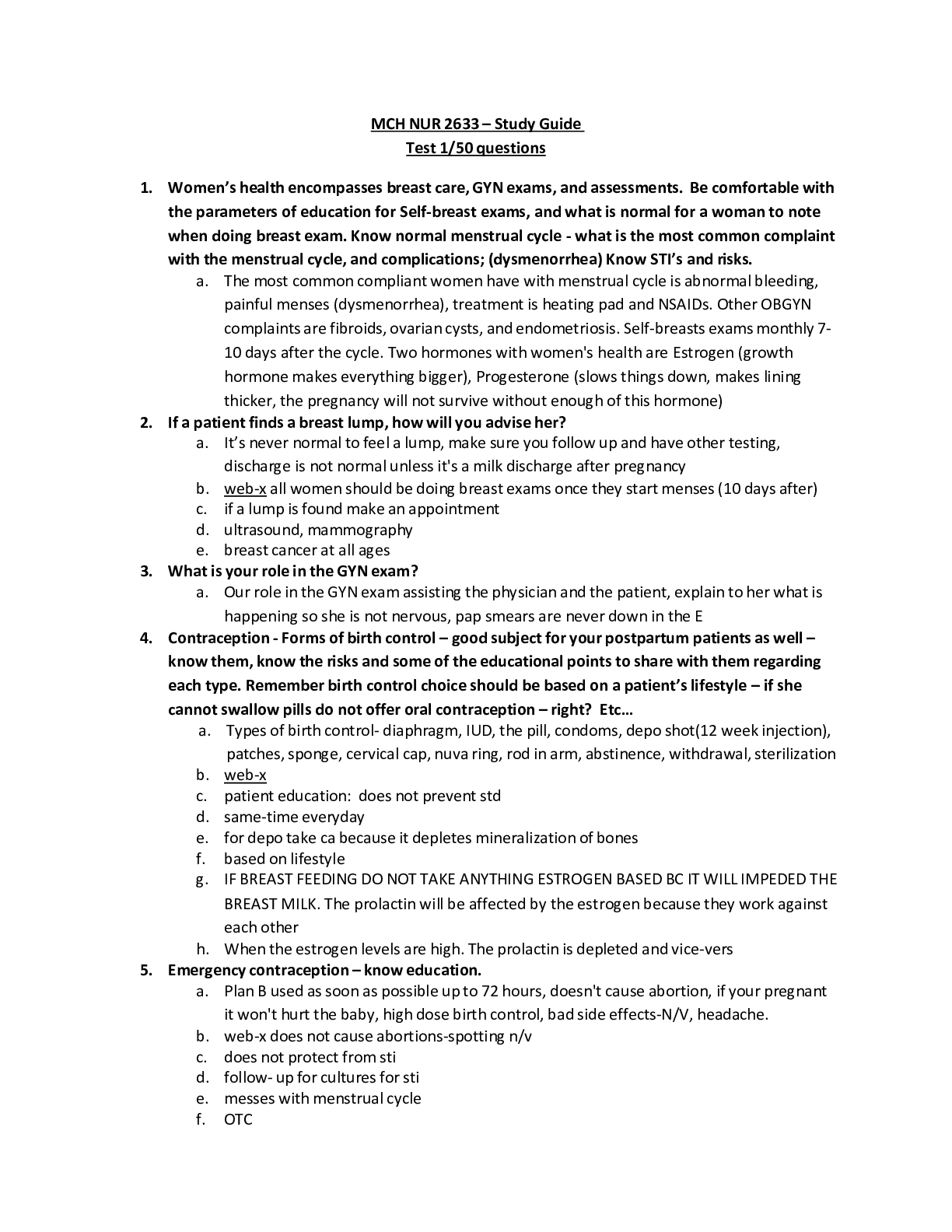
Buy this document to get the full access instantly
Instant Download Access after purchase
Add to cartInstant download
Reviews( 0 )
Document information
Connected school, study & course
About the document
Uploaded On
Oct 23, 2021
Number of pages
14
Written in
Additional information
This document has been written for:
Uploaded
Oct 23, 2021
Downloads
0
Views
30











